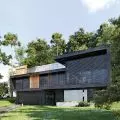The Malopolska Science Center Cogiteon will open in Krakow's Czyżyny district as early as June 21, with architecture by Heinle, Wischer und Partner Architects and an exhibition designed by Krakow's Koza Nostra office. The impressive realization arouses interest, but also controversy - was the site where the headquarters of the new institution was erected properly chosen? We bring you closer to the most important aspects of the dispute surrounding the construction of the Cogiteon.
First airport of the Republic
The new headquarters of the Malopolska Science Center Cogiteon has been located on the site of the former Rakowice-Czyżyny airport, a place important not only from the point of view of history and the protection of national heritage, but also of the local community. The history of Rakowice-Czyżyny airport dates back to 1912, when one of the earliest military air bases in Europe was planned there on an Austro-Hungarian initiative. Six years later, the base became the first airport in the reborn Republic of Poland, which also began operating passenger flights in 1923. The airport's operational activities ended in 1963, but this did not mean the end of its history. Part of the land it occupied was developed for the Aviation Museum, established in 1966, which after more than four decades, in 2010 lived to see a spectacular headquarters designed by Pysall.Ruge Architekten and Bartłomiej Kisielewski(Horizone Studio). However, a significant part of the former airport remained undeveloped, becoming a recreational space intensively used by people living in nearby housing estates, including the Akademicki estate and the 303 Division. After 1963, the Rakowice-Czyżyny airport area functioned as a place for children's games, neighborhood gatherings, mass events and even a Guinness World Record. The areas around the runways were transformed into valuable, especially today, green areas - meadows and densely covered groves, which serve not only residents, but also serve as habitats for the numerous animals found there; hares, pheasants or corncrakes. The socially and historically significant area has twice become the subject of a listing on the Register of Historic Places, which was sought by none other than the local community. Unfortunately, despite legal protection, the undeveloped area of the airfield has been diminishing over the years - significant transformations began in 2013, when construction of the infamous Avia housing development began. As part of it, part of the runway's concrete pavement was torn up and areas on its eastern side were densely developed, irrevocably changing their recreational character. The progressive degradation of the Rakowice-Czyżyny airport area is being fought by a group of community activists associated with the site, including the Czyżyny Blonia Association and the Wspólne Czyżyny Association.
Malopolska Science Center Cogiteon - bird's eye view in 2020
photo: Olos88 | © Wikimedia Commons, public domain
An unwanted center?
Contrary to the expectations of residents and community activists, the airport's green space resource was depleted by another area, which in 2017 was earmarked for the construction of the Malopolska Cogiteon Science Center. People associated with the protection of the green character of the airport's grounds have pointed out the problems associated with the investment from the first moments after it was announced. Among the most significant of these were certainly the lack of public consultation, the transformation of the historic character of the airport or the devastation of green areas, including the cutting down of several hundred trees and the elimination of natural bird habitats. In the course of the discussion, there were proposals to move the planned Center to other locations - it was suggested, among other things, that the Krakow Plaza shopping complex or buildings on Wesola Street could be adapted for this purpose, or that Cogiteon's headquarters could be built in the Branice Science and Technology Park, being developed as part of the Nowa Huta Przyszłości initiative. Despite numerous objections, taking into account factors such as the ownership status of the plot and its transportation accessibility, the final decision was made to build the Center on the site of the historic Rakowice-Czyżyny airport. A consequence of the start of construction was the need to design access to the emerging facility. After a heated debate and public consultations this time, it was decided on the variant providing for routing the access road from Stella-Sawickiego Street. The decision was made, once again, without taking into account the will of residents and the results of the aforementioned consultations.
The routing of the road, which was completed in 2023, resulted not only in the felling of a significant number of trees and the devastation of the green areas located there - the development of access to the plots located along the newly created street threatened to further transform the neighborhood. As indicated by residents and other people involved in protecting the green areas of the Rakowice-Czyżyny airport, it was the lack of an access road that hindered the issuance of zoning permits to further entities wishing to develop the area. These include the Cracow University of Technology, which as early as 2022 presented a concept for the development of plots belonging to it, among which is the quarter between the Cogiteon and the Academic Estate, overgrown with dense vegetation. The city needs this kind of facilities, as we wrote about in the context of the Kamionka dispute, but they should not be built at the expense of green areas, extremely valuable in such densely built-up districts as Krakow's Czyżyny. The confusion and potentially disastrous consequences for the character of the neighborhood could perhaps have been avoided by choosing one of the alternative variants for the construction of an access road to the Malopolska Science Center - among them was the concept of routing the access road from Bora-Komorowskiego Avenue, where there is already an unpaved technical access, successfully used by those working on the construction of the Cogiteon. However, the variant was rejected, which was justified by the high cost of its implementation and the need to transform the existing road infrastructure.
Malopolskie Centrum Nauki Cogiteon - the plot of land between the Malopolskie Centrum Nauki Cogiteon and the Academic Estate
photo: Przemyslaw Ciępka
Concerns over the top?
However, writing about the almost-open Malopolska Science Center Cogiteon, one can't help but notice the positive aspects of the investment. Selected in the competition announced by SARP, the project by Heinle Wischer und Partner Architekci is characterized by sensitivity, expressed in the handling of a modern, distinctive body, while minimally interfering with the landscape character of the Rakowice-Czyżyny airport. The impressive rooftop garden emerges imperceptibly from the horizon line, offering visitors a green space equipped with viewpoints, benches, flower meadows and small installations with educational functions. On the western side of the plot occupied by Cogiteon is a sizable playground, which is accessible to all interested parties both from Bora-Komorowskiego Avenue and from the airport grounds. Even two weeks before the opening of the Center itself, the playground was besieged by families with children, indicating the need for such an attraction in the area. The paved plaza on the eastern side of the building is a bit more questionable - however, when deciding to criticize it, one must take into account its function, as it will include a surface parking lot for coaches and an entrance to the underground parking lot. The significant number of parking spaces is expected to prevent visitors to the Center from leaving their cars on the surface of the historic runway, as was feared by those opposed to the development. Even the most intensely protested aspect of the investment - the access road, leading from Stella-Sawickiego Street along the runway, has its advantages - thanks to it, the area around Życzkowskiego and Skarżyńskiego Streets will be supplied with the public transportation desired by residents.
Malopolska Science Center Cogiteon - view of the green roof from the side of the runway
Photo: Przemyslaw Ciępka
significant conclusions
Can it be concluded, then, that public opposition to the construction of the Cogiteon proved unjustified? It seems that the process of erecting the Center was carried out in a way that prioritized the least possible interference with the landscape and social character of the part of the airport it occupies, while enriching it with new attractions. The problem, therefore, is not the investment itself, but rather the circumstances and potential consequences of its completion, which primarily include allowing further development of the green areas of the Rakowice-Czyżyny airport. The Cogiteon case has also drawn attention to other, perhaps even more important issues - the first of which is the participation of local communities in shaping the spaces they use. Unfortunately, despite numerous initiatives, in the case of Cogiteon the opinion of those most strongly connected with the areas under dispute remained unheeded at various stages of the project. This seems to be a practice that is not only highly inappropriate, but also sets a dangerous precedent for the future. The discussion that has arisen around the construction of the Malopolska Science Center also makes it possible to pose a question that is far too rarely asked in an era of numerous architectural investments - do we really need to build? The example of the history of the use of the Rakowice-Czyżyny airport land shows that not always, and theoretically undeveloped areas can be active not only biologically, but also socially.




























